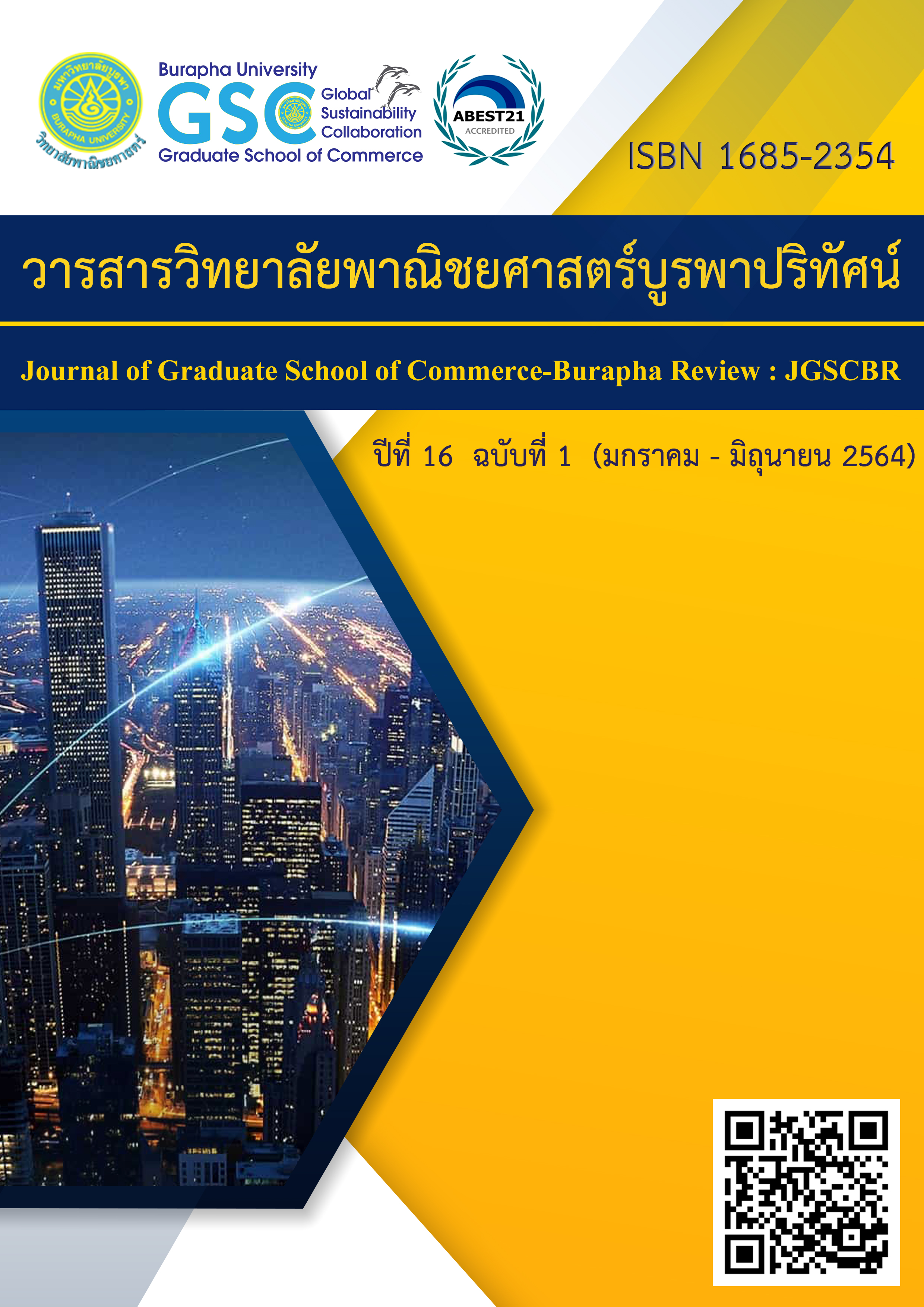PERCEIVED USEFULNESS, PERCEIVED EASE OF USE AND INTENTION TO USE MOBILE BANKING APPLICATIONS AMONG ENTERPRISE OF SOLE PROPRIETORSHIP
Main Article Content
Abstract
Among the marketing competition of the digital age, the SME business owners have to focus on applying the technology into their business to respond the faster and more intense competition in the future. At present, mobile banking applications are considered as the key tool to enhance the business effectiveness. So, developing mobile banking applications into continuous use is crucial. The purposes of this research are 1) to measure the perceived ease of use and the perceived usefulness of mobile banking applications of the enterprise of sole proprietorship 2) to study the perceived usefulness influencing over the intention to use mobile banking applications among the enterprise of sole proprietorship 3) to study the perceived ease of use influencing over the Intention to use mobile banking applications among the enterprise of sole proprietorship by using multi-stage sampling and analyzing the simple regression by setting the level of statistical significance at 0.05
The research shows that the level of the perceived usefulness and the perceived ease of use is Totally Agree. The perceived usefulness and the perceived ease of use are statistically significant in positively influencing the intention to use mobile banking applications among the enterprise of sole proprietorship.
Article Details
The owner of the article does not copy or violate any of its copyright. If any copyright infringement occurs or prosecution, in any case, the Editorial Board is not involved in all the rights to the owner of the article to be performed.
References
กิตติยาพร ทองไทย. (2559). การยอมรับการใช้เวชระเบียนอิเล็กทรอนิกส์ของคลินิกแพทย์และทันตแพทย์. วิทยานิพนธ์. มหาวิทยาลัยอุบลราชธานี. อุบลราชธานี.
เกศรินทร์ หงษ์ทอง, เฉลิมศักดิ์ เลิศวงศ์เสถียร, อภิรดา สุทธิสานนท์ และดารณี พิมพ์ช่างทอง. (2559). ปัจจัยที่มีผลต่อการยอมรับระบบวางแผนทรัพยากรขององค์กร กรณีศึกษา: บริษัทกระดาษสติ๊กเกอร์ (ประเทศไทย) จำกัด. วารสารบัณฑิตศึกษา. ปีที่ 13 ฉบับที่ 63 (ตุลาคม – ธันวาคม).
ชูชัย สมิทธิไกร. (2557). พฤติกรรมผู้บริโภค. (พิมพ์ครั้งที่ 4). กรุงเทพฯ: วี. พริ้นท์ (1991).
นุชจรี จินดาวรรณ. (2559). การทดสอบปัจจัยที่มีอิทธิพลต่อการตั้งใจใช้บริการอินเตอร์เน็ตแบงค์กิ้ง กรณีศึกษา ลูกค้าธนาคารกรุงไทย จำกัด (มหาชน) ในจังหวัดพัทลุง. วิทยานิพนธ์. มหาวิทยาลัยสงขลานครินทร์. สงขลา.
นันท์ธิดา ทองดี. (2561). อิทธิพลภาพลักษณ์องค์กร การยอมรับเทคโนโลยี และการรับรู้ความเสี่ยงที่มีอิทธิพลต่อการตัดสินใจเลือกใช้กระเป๋าเงินอิเล็กทรอนิกส์ของผู้ใช้บริการในเขตกรุงเทพมหานคร. วิทยานิพนธ์. มหาวิทยาลัยเทคโนโลยีราชมงคลธัญบุรี. ปทุมธานี.
ปาลิณี ตีรบุลกุล. (2560). ปัจจัยที่มีอิทธิพลต่อความตั้งใจในการกลับมาใช้ซ้ำและความตั้งใจในการบอกต่อคราวด์ซิ่งที่มีการผสมผสานเกม. วิทยานิพนธ์. จุฬาลงกรณ์มหาวิทยาลัย. กรุงเทพฯ.
ปิยนุช พละเยี่ยม และ ชลิตา ศรีนวล. (2561). ความตั้งใจใช้บริการทางการเงินผ่านระบบพร้อมเพย์ของผู้บริโภคในเขตกรุงเทพมหานคร. วารสารปัญญาภิวัฒน์. ปีที่ 10 ฉบับที่ 3 (กันยายน – ธันวาคม).
ปิยพงศ์ ตั้งจินตนาการ และพิชญ์สินี โพธิจิตติ. (2560). Mobile Banking ธนาคารในยุค Digital. (Online). www.gsb.or.th/getattachment/8d7a5d95-b808-49b4-a871-7f985f1f7d38/2IN_hotissue_Digital_bank_detail.aspx, 7 มิถุนายน 2562.
ปุณพีร์ สิทธิกิจ และ พิมพ์มณี รัตนวิชา. (2562). ปัจจัยที่มีผลต่อความตั้งใจในการกลับมาใช้ซ้ำและการบอกต่อของแอพพลิเคชันที่ใช้เทคโนโลยีความเป็นจริงเสริม: กรณีศึกษาของแอพพลิเคชันอัตราแลกเปลี่ยนสกุลเงินต่างประเทศในอาเซียน. วารสารนวัตกรรมและเทคโนโลยีเพื่อการเรียนรู้. ปีที่ 2 ฉบับที่ 2 (กรกฎาคม – ธันวาคม).
พนิดา จงสุขสมสกุล. (2561). การสร้างและการตรวจสอบคุณภาพเครื่องมือวิจัย. (Online). www.research.nu.ac.th/th/signup/hen6/APanida.pdf, 23 มิถุนายน 2563.
พรชัย ลิขิตธรรมโรจน์. (2545). พฤติกรรมองค์การ. กรุงเทพฯ: โอ.เอส.พริ้นติ้งเฮาส์.
พรชัย ฬิลหาเวสส. (2559). บริการทางการเงินผ่านโทรศัพท์เคลื่อนที่: สะดวก รวดเร็ว และปลอดภัย. ธนาคารแห่งประเทศไทย. (Online). www.bot.or.th/Thai/ResearchAndPublications/DocLib_/article_24_07_57.pdf, 9 ตุลาคม 2562.
พรศรี ลีลาพัฒนวงศ์ และ ทิพวรรณ ปิ่นวนิชย์กุล. (2562). ปัจจัยที่มีอิทธิพลต่อการยอมรับนวัตกรรมและเทคโนโลยี: กรณีศึกษายานยนต์ไฟฟ้าประเภทยานยนต์นั่งส่วนบุคคลไม่เกิน 7 คน (รย.1). วารสารวิจัยและพัฒนา มจธ. ปีที่ 42 ฉบับที่ 2 (เมษายน – มิถุนายน).
ภัทราวดี ทองมาลา. (2558). การยอมรับระบบการจัดซื้อจัดจ้างด้วยอิเล็กทรอนิกส์ (e-GP) ของเจ้าหน้าที่พัสดุของมหาวิทยาลัยเทคโนโลยีราชมงคล. วิทยานิพนธ์. มหาวิทยาลัยเทคโนโลยีราชมงคล. ปทุมธานี.
วริษฐา สุริยไพฑูรย์. (2560). อิทธิพลของการรับรู้ความมีประโยชน์และความง่ายในการใช้งานที่ส่งผลต่อทัศนคติและความตั้งใจซื้อสินค้าแฟชั่นของผู้บริโภคผ่านระบบพาณิชย์บนโทรศัพท์เคลื่อนที่. วิทยานิพนธ์. มหาวิทยาลัยสงขลานครินทร์. สงขลา.
วันทนีย์ มงคลทรัพย์กุล, อัญณิฐา ดิษฐานนท์, อรพรรณ คงมา, มาลัย และ จันทร์จิรา นพคุณธรรมชาติ. (2559). ปัจจัยที่มีผลต่อการยอมรับบริการอิเล็กทรอนิกส์ภาครัฐ: กรณีศึกษาการยื่นแบบและชำระภาษีออนไลน์. วารสารวิจัยและพัฒนา มจธ. ปีที่ 39 ฉบับที่ 1 (มกราคม – มีนาคม).
ศรุตา สายบัวต่อ และ กนกกาญจน์ นมะหุต. (2562). รูปแบบการยอมรับพฤติกรรมความต้งใจในการใช้บริการสมาร์ทแอพพลิเคชั่นเพื่อสุขภาพของ Gen X. วารสารบริหารธุรกิจศรีนครินทรวิโรฒ. ปีที่ 10 ฉบับที่ 2 (กรกฎาคม-ธันวาคม).
ศูนย์วิจัยธนาคารออมสิน. (2563). ธุรกิจธนาคารเร่งปรับตัว พร้อมรับมือ New Normal. (Online). www.gsbresearch.or.th/wpcontent/uploads/2020/06/IN_Hotissue_New_Normal_internet_detail.pdf, 15 ตุลาคม 2563.
สำนักงานคณะกรรมการพัฒนาการเศรษฐกิจและสังคมแห่งชาติ. (2561). เศรษฐกิจดิจิทัล (Digital Economy) กับอนาคตประเทศไทย. วารสารเศรษฐกิจและสังคม. ปีที่ 53 ฉบับที่ 2 (เมษายน – มิถุนายน).
สำนักงานพัฒนาธุรกรรมทางอิเล็กทรอนิกส์. (2561). Mobile Banking รูปแบบใหม่ กับฟีเจอร์เพื่อผู้ประกอบการ e-Commerce. (Online). https://www.etda.or.th/content/mobile-banking-features-for-e-commerce.html, 15 มิถุนายน 2563.
สำนักงานส่งเสริมวิสาหกิจขนาดกลางและขนาดย่อม(สสว.). (2560). แผนการส่งเสริมSME ฉบับที่ 4 (พ.ศ. 2560-2564). (Online). shorturl.at/rxEM0, 16 มิถุนายน 2563.
สิริสุดา รอดทอง. (2556). ความตั้งใจในการดาวน์โหลดโมบายแอพพลิเคชั่นของผู้ใช้โทรศัพท์เคลื่อนที่ในกลุ่มสมาร์ทโฟน. วิทยานิพนธ์. มหาวิทยาลัยเทคโนโลยีราชมงคลธัญบุรี. กรุงเทพฯ.
โสภณ วิจิตรเมธาวณิชย์. (2562). การพัฒนาของธุรกิจธนาคารในโลกดิจิทัล. (Online). https://www.bot.or.th/Thai/ResearchAndPublications/articles/Pages/Article_15Apr2020.aspx, 15 มิถุนายน 2563.
Aggelidis V.P and Chatzoglou P.D. (2009). Using modified technology acceptance model in hospitals. International journal of medical informatics. 78(2), 115-126.
Al-Fahim, N. H., Jusoh, W. J. W., & Abideen, A. (2016). An examination factors influencing the intention to adopt internet banking among smes in yemen: using an extension of the technology acceptance model (TAM). Journal of Internet Banking and Commerce, 21(S5).
Davis, F. D. (1989). Perceived Usefulness, Perceived Ease of Use, and User Acceptance of Information Technology. MIS Quarterly, 13 (3), 319-340.
Hart, A.O, Nwibere, B.M, Inyang, B.J. (2010). The uptake of electronic commerce by SMEs: A metatheoretical framework expanding the determining constructs of TAM and TOE frameworks. Journal of Global Business Technology. 6 (1).
Legris, P., Ingham, J., and Collerette, P. (2003). Why do people use information technology? A critical review of the technology acceptance model. Information and Management, 40(3), 191–204.
Schramm Wilbur. (1960). The Process and Effects of Mass Communication. Urbana: University of Illinois Press.
V. Venkatesh, M. Morris, and G. B. Davis. (2003). User acceptance of information technology: Toward a unified view. MIS Quarterly, vol. 27(3), 425-47.


